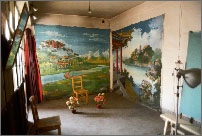June 11, 2007
La Jarra de la Leche
On our kitchen table you'll find a porcelain pitcher. Right now it's full of small white flowers my wife bought at a deli down the street. The pitcher is a pretty but unremarkable object. The handle has a bit of art nouveau flourish. The finish you'll notice if you study it closely, is full of hairline cracks. The bottom is stamped with a royal looking insignia and below the words:
Royal Ironstone China
Wood and Son, England.
My great grandfather gave the pitcher as a gift to my great grandmother. Ignacio Perez was a major in Pancho Villa's army and never returned home from his excursions without gifts in hand. A set of 6 teacups was meant to be included with the pitcher but only one survived the hard riding over mountains and deserts. On his way home he had used the pitcher for coffee, but before arriving, he cleaned the thing, and wrapped it in nice paper before presenting it to his wife. My great grandmother, Mama Juela as she was known to all, was delighted by the gift and immediately deemed it 'La Jarra de la Leche' or 'the pitcher of the milk' and for years that's exactly what it was. Every morning one child would milk the cows, and boil the milk for the day. This was no trivial task as there was no refrigeration and fires were made from mesquite wood. After the milk was boiled, the curd was scraped, and then hot milk was poured into the pitcher where it would cool. On the rare occasions she had chocolate in house, Mama Juela would crumble some into the milk. She also liked to mix in a drop or two of honey. At Rancho Cascabel 22 people lived under one roof. There were 11 children, several adoptees, a few old maid sisters, and a ranch hand or two so Mama Juela rarely left the kitchen. The pitcher was being filled and emptied all day long.
When Mama Juela died the pitcher was one of the few things my grandmother took from the house.
By my childhood in the 70's milk was delivered daily to my grandmother's doorstep in small glass bottles with tin lids. I was given the task of boiling the milk and removing the curd. Normally we'd just pour the milk back in the bottles, but if there happed to be chocolate in the house we would take out the pitcher, pour in the warm milk, and drop in bits chocolate in watching them dissolve as we stirred. Otherwise the pitcher was only used for special occasions—Christmas dinners mainly. It was kept behind glass with along with porcelain figurines never removed from their shrinkwrap.
When my grandmother died it was my father who brought the pitcher home to his empty house, carrying it by hand on the plane back to Texas where it mainly sat unused on a shelf. A few years later I claimed it, driving it myself to California. When Jenn came into the picture, she started using the pitcher as to hold flowers.
My thought tonight is this: When I am gone will this thing, this ordinary pitcher, be one of the things my children will want to hold close or will too much time have passed for the memories contained in the thing to be read? Will they understand why the milk poured from this pitcher tastes so sweet?



06/11/07 07:35 AM
tom said...
i'd love to see a photo of it
06/11/07 01:48 PM
olivier said...
Raul,
Your boys will probably break it some day, which is the best way for a family heirloom to end its days. At some point everything has to break. But if the pitcher stays in one piece and there's enough room in it for you and your ashes just use it as an urn and have them bury you in it in the desert and call it " La Jarra de Gutierrez". With any luck a desert highway will be named after it.
06/11/07 05:34 PM
Sarah said...
There is something so wonderful about holding an object in your hands knowing that so many people that you have loved, or maybe even hated sometimes, held it. It is a jug. It has held milk and now holds flowers but so many people have got it down from the shelf and have carried it and poured from it and even before then it had is own travelling story. I wish I had something like that. Try not to break it ;-)
06/12/07 01:45 AM
MadMolecule said...
It's a complex issue. On the one hand, I love the intergenerational continuity represented by the pitcher; I'm a sucker for old things, and still write on a desk that was used by my great-grandmother in the 1920s. I'm also a photography nut, and I love getting old cameras into working order and shooting with them; the knowledge that someone was shooting vacation shots with this camera 70 years ago is a dizzying wonder.
On the other hand, I have an instinctive distrust of the fetishism and idol-worship that seems to accrete around heirlooms and such. As Olivier wisely said above, "at some point everything has to break"; the notion of putting a near-mystical importance onto a physical, frangible object upsets me on an intellectual level in that it seems a misplacement of energy, of focus.
Still, I'd love to see a photo or two of that pitcher.
06/12/07 03:38 PM
Bandit said...
My Mother recently passed away. She had made a will and made sure that each of her boys received a piece from HER Great Grandmother's tea set.
While the tea set itself is not remarkable, valuable or even functional (the sugarbowl I received has many so many chips and cracks in it, it would probably shatter if you actually put a lot of sugar in it) it is a priceless link to my past.